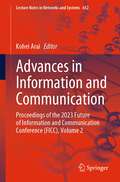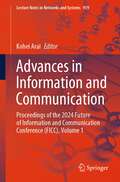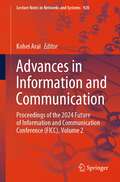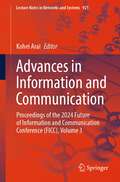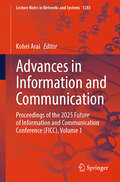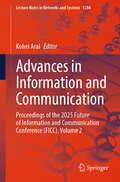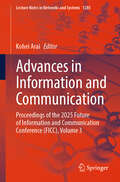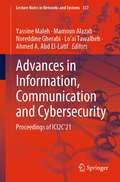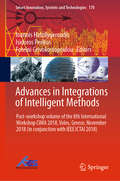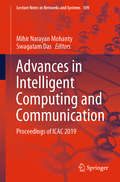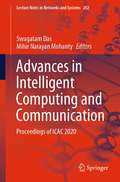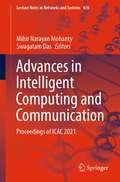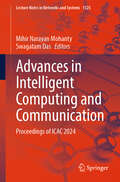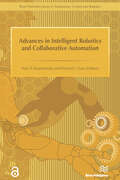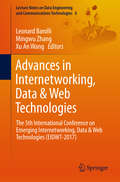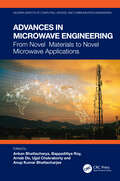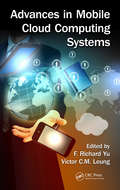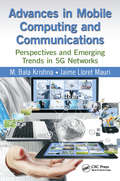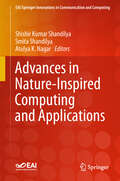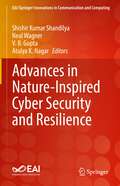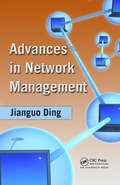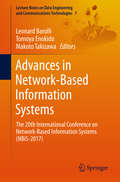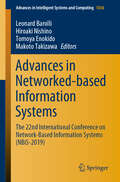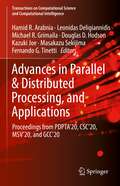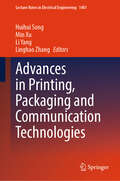- Table View
- List View
Advances in Information and Communication: Proceedings of the 2023 Future of Information and Communication Conference (FICC), Volume 2 (Lecture Notes in Networks and Systems #652)
by Kohei AraiThis book gathers the proceedings of the eighth Future of Information and Computing Conference, which was held successfully in virtual mode. It received a total of 369 paper submissions from renowned and budding scholars, academics, and distinguished members of the industry. The topics fanned across various fields involving computing, Internet of Things, data science, and artificial intelligence.Learned scholars from all walks of life assembled under one roof to share their unique, original, and breakthrough researches and paved a new technological path for the world. Many of the studies seek to change the face of the world itself. Their innovative thinking indeed aims to solve several gruesome problems in the field of communication, data science, ambient intelligence, networking, computing, security, and privacy.The authors have strived to render valuable pieces of study in this edition and hope to acquire enthusiastic support from the readers.
Advances in Information and Communication: Proceedings of the 2024 Future of Information and Communication Conference (FICC), Volume 1 (Lecture Notes in Networks and Systems #919)
by Kohei AraiThe book is a valuable collection of papers presented in the Future of Information and Communications Conference (FICC), conducted by Science and Information Organization on 4–5 April 2024 in Berlin. It received a total of 401 paper submissions out of which 139 are published after careful double-blind peer-review.Renowned and budding scholars, academics, and distinguished members of the industry assembled under one roof to share their breakthrough research providing answers to many complex problems boggling the world. The topics fanned across various fields involving Communication, Data Science, Ambient Intelligence, Networking, Computing, Security, and Privacy.
Advances in Information and Communication: Proceedings of the 2024 Future of Information and Communication Conference (FICC), Volume 2 (Lecture Notes in Networks and Systems #920)
by Kohei AraiThe book is a valuable collection of papers presented in the Future of Information and Communications Conference (FICC), conducted by Science and Information Organization on 4–5 April 2024 in Berlin. It received a total of 401 paper submissions out of which 139 are published after careful double-blind peer-review. Renowned and budding scholars, academics, and distinguished members of the industry assembled under one roof to share their breakthrough research providing answers to many complex problems boggling the world. The topics fanned across various fields involving Communication, Data Science, Ambient Intelligence, Networking, Computing, Security, and Privacy.
Advances in Information and Communication: Proceedings of the 2024 Future of Information and Communication Conference (FICC), Volume 3 (Lecture Notes in Networks and Systems #921)
by Kohei AraiThe book is a valuable collection of papers presented in the Future of Information and Communications Conference (FICC), conducted by Science and Information Organization on 4–5 April 2024 in Berlin. It received a total of 401 paper submissions out of which 139 are published after careful double-blind peer-review. Renowned and budding scholars, academics, and distinguished members of the industry assembled under one roof to share their breakthrough research providing answers to many complex problems boggling the world. The topics fanned across various fields involving Communication, Data Science, Ambient Intelligence, Networking, Computing, Security, and Privacy.
Advances in Information and Communication: Proceedings of the 2025 Future of Information and Communication Conference (FICC), Volume 1 (Lecture Notes in Networks and Systems #1283)
by Kohei AraiThis book comprises the proceedings of the Future of Information and Communication Conference (FICC) 2025, held on 28–29 April 2025 in Berlin, Germany. The conference brought together leading researchers, industry experts, and academics from across the globe to discuss the latest advancements, challenges, and opportunities in the rapidly evolving field of information and communication technologies. The conference received an impressive 401 submissions, of which 138 high-quality papers were selected after a rigorous peer-review process. These contributions span a diverse range of topics, including artificial intelligence, cybersecurity, data science, networking, human-computer interaction, and more. FICC 2025 provided an engaging platform for collaboration and knowledge exchange, highlighting state-of-the-art research and practical solutions to global challenges. This proceedings book serves as a valuable resource for researchers, practitioners, and innovators seeking insights into the future of information and communication technologies.
Advances in Information and Communication: Proceedings of the 2025 Future of Information and Communication Conference (FICC), Volume 2 (Lecture Notes in Networks and Systems #1284)
by Kohei AraiThis book comprises the proceedings of the Future of Information and Communication Conference (FICC) 2025, held on 28-29 April 2025 in Berlin, Germany. The conference brought together leading researchers, industry experts, and academics from across the globe to discuss the latest advancements, challenges, and opportunities in the rapidly evolving field of information and communication technologies. The conference received an impressive 401 submissions, of which 138 high-quality papers were selected after a rigorous peer-review process. These contributions span a diverse range of topics, including artificial intelligence, cybersecurity, data science, networking, human–computer interaction, and more. FICC 2025 provided an engaging platform for collaboration and knowledge exchange, highlighting state-of-the-art research and practical solutions to global challenges. This proceedings book serves as a valuable resource for researchers, practitioners, and innovators seeking insights into the future of information and communication technologies.
Advances in Information and Communication: Proceedings of the 2025 Future of Information and Communication Conference (FICC), Volume 3 (Lecture Notes in Networks and Systems #1285)
by Kohei AraiThis book comprises the proceedings of the Future of Information and Communication Conference (FICC) 2025, held on 28-29 April 2025 in Berlin, Germany. The conference brought together leading researchers, industry experts, and academics from across the globe to discuss the latest advancements, challenges, and opportunities in the rapidly evolving field of information and communication technologies. The conference received an impressive 401 submissions, of which 138 high-quality papers were selected after a rigorous peer-review process. These contributions span a diverse range of topics, including artificial intelligence, cybersecurity, data science, networking, human–computer interaction, and more. FICC 2025 provided an engaging platform for collaboration and knowledge exchange, highlighting state-of-the-art research and practical solutions to global challenges. This proceedings book serves as a valuable resource for researchers, practitioners, and innovators seeking insights into the future of information and communication technologies.
Advances in Information, Communication and Cybersecurity: Proceedings of ICI2C’21 (Lecture Notes in Networks and Systems #357)
by Yassine Maleh Mamoun Alazab Lo’ai Tawalbeh Noreddine Gherabi Ahmed A. Abd El-LatifThis book gathers the proceedings of the International Conference on Information, Communication and Cybersecurity, held on November 10–11, 2021, in Khouribga, Morocco. The conference was jointly coorganized by The National School of Applied Sciences of Sultan Moulay Slimane University, Morocco, and Charles Darwin University, Australia. This book provides an opportunity to account for state-of-the-art works, future trends impacting information technology, communications, and cybersecurity, focusing on elucidating the challenges, opportunities, and inter-dependencies that are just around the corner. This book is helpful for students and researchers as well as practitioners.ICI2C 2021 was devoted to advances in smart information technologies, communication, and cybersecurity. It was considered a meeting point for researchers and practitioners to implement advanced information technologies into various industries. There were 159 paper submissions from 24 countries. Each submission was reviewed by at least three chairs or PC members. We accepted 54 regular papers (34\%). Unfortunately, due to limitations of conference topics and edited volumes, the Program Committee was forced to reject some interesting papers, which did not satisfy these topics or publisher requirements. We would like to thank all authors and reviewers for their work and valuable contributions. The friendly and welcoming attitude of conference supporters and contributors made this event a success!
Advances in Integrations of Intelligent Methods: Post-workshop volume of the 8th International Workshop CIMA 2018, Volos, Greece, November 2018 (in conjunction with IEEE ICTAI 2018) (Smart Innovation, Systems and Technologies #170)
by Ioannis Hatzilygeroudis Isidoros Perikos Foteini GrivokostopoulouThis book presents a number of research efforts in combining AI methods or techniques to solve complex problems in various areas. The combination of different intelligent methods is an active research area in artificial intelligence (AI), since it is believed that complex problems can be more easily solved with integrated or hybrid methods, such as combinations of different soft computing methods (fuzzy logic, neural networks, and evolutionary algorithms) among themselves or with hard AI technologies like logic and rules; machine learning with soft computing and classical AI methods; and agent-based approaches with logic and non-symbolic approaches. Some of the combinations are already extensively used, including neuro-symbolic methods, neuro-fuzzy methods, and methods combining rule-based and case-based reasoning. However, other combinations are still being investigated, such as those related to the semantic web, deep learning and swarm intelligence algorithms. Most are connected with specific applications, while the rest are based on principles.
Advances in Intelligent Computing and Communication: Proceedings of ICAC 2019 (Lecture Notes in Networks and Systems #109)
by Swagatam Das Mihir Narayan MohantyThis book features high-quality research papers presented at the 2nd International Conference on Intelligent Computing and Advances in Communication (ICAC 2019), held at Siksha ‘O’ Anusandhan Deemed to be University, Bhubaneswar, Odisha, India, in November 2019. Covering a wide variety of topics, including management of clean and smart energy systems and environmental challenges, it is a valuable resource for researchers and practicing engineers working in various fields of renewable energy generation, and clean and smart energy management.
Advances in Intelligent Computing and Communication: Proceedings of ICAC 2020 (Lecture Notes in Networks and Systems #202)
by Swagatam Das Mihir Narayan MohantyThis book presents high-quality research papers presented at the 3rd International Conference on Intelligent Computing and Advances in Communication (ICAC 2020) organized by Siksha ‘O’ Anusandhan Deemed to be University, Bhubaneswar, Odisha, India, in November 2020. This book brings out the new advances and research results in the fields of theoretical, experimental, and applied signal and image processing, soft computing, networking, and antenna research. Moreover, it provides a comprehensive and systematic reference on the range of alternative conversion processes and technologies.
Advances in Intelligent Computing and Communication: Proceedings of ICAC 2021 (Lecture Notes in Networks and Systems #430)
by Swagatam Das Mihir Narayan MohantyThe book presents high-quality research papers presented at 4th International Conference on Intelligent Computing and Advances in Communication (ICAC 2021) organized by Siksha ‘O’ Anusandhan, Deemed to be University, Bhubaneswar, Odisha, India, in November 2021. This book brings out the new advances and research results in the fields of theoretical, experimental, and applied signal and image processing, soft computing, networking, and antenna research. Moreover, it provides a comprehensive and systematic reference on the range of alternative conversion processes and technologies.
Advances in Intelligent Computing and Communication: Proceedings of ICAC 2024 (Lecture Notes in Networks and Systems #1325)
by Swagatam Das Mihir Narayan MohantyThis book presents high-quality research papers presented at 5th International Conference on Intelligent Computing and Advances in Communication (ICAC 2024) organized by Siksha &‘O&’ Anusandhan, deemed to be university, Bhubaneswar, Odisha, India, in December 2024. This book brings out the new advances and research results in the fields of theoretical, experimental, and applied signal and image processing, soft computing, networking, and antenna research. Moreover, it provides a comprehensive and systematic reference on the range of alternative conversion processes and technologies.
Advances in Intelligent Robotics and Collaborative Automation (River Publishers Series In Automation, Control And Robotics Ser.)
by Yuriy Kondratenko Richard DuroThis book provides an overview of a series of advanced research lines in robotics as well as of design and development methodologies for intelligent robots and their intelligent components. It represents a selection of extended versions of the best papers presented at the Seventh IEEE International Workshop on Intelligent Data Acquisition and Advanced Computing Systems: Technology and Applications IDAACS 2013 that were related to these topics. Its contents integrate state of the art computational intelligence based techniques for automatic robot control to novel distributed sensing and data integration methodologies that can be applied to intelligent robotics and automation systems. The objective of the text was to provide an overview of some of the problems in the field of robotic systems and intelligent automation and the approaches and techniques that relevant research groups within this area are employing to try to solve them.The contributions of the different authors have been grouped into four main sections:• Robots• Control and Intelligence• Sensing• Collaborative automationThe chapters have been structured to provide an easy to follow introduction to the topics that are addressed, including the most relevant references, so that anyone interested in this field can get started in the area.
Advances in Internetworking, Data & Web Technologies: The 5th International Conference on Emerging Internetworking, Data & Web Technologies (EIDWT-2017) (Lecture Notes on Data Engineering and Communications Technologies #6)
by Leonard Barolli Mingwu Zhang Xu An WangThis book highlights the latest research findings, innovative research results, methods and development techniques, from both theoretical and practical perspectives, in the emerging areas of information networking, data and Web technologies. It gathers papers originally presented at the 5th International Conference on Emerging Internetworking, Data & Web Technologies (EIDWT-2017) held 10-11 June 2017 in Wuhan, China. The conference is dedicated to the dissemination of original contributions that are related to the theories, practices and concepts of emerging internetworking and data technologies - and most importantly, to how they can be applied in business and academia to achieve a collective intelligence approach. Information networking, data and Web technologies are currently undergoing a rapid evolution. As a result, they are now expected to manage increasing usage demand, provide support for a significant number of services, consistently deliver Quality of Service (QoS), and optimize network resources. Highlighting these aspects, the book discusses methods and practices that combine various internetworking and emerging data technologies to capture, integrate, analyze, mine, annotate, and visualize data, and make it available for various users and applications.
Advances in Microwave Engineering: From Novel Materials to Novel Microwave Applications (Modern Aspects of Computing, Devices, and Communication Engineering)
by Arnab De Ankan Bhattacharya Bappadittya Roy Ujjal Chakraborty Anup Kumar BhattacharjeeThis text showcases recent advancements in the field of microwave engineering, starting from the use of innovative materials to the latest microwave applications. It also highlights safety guidelines for exposure to microwave and radio frequency energy. The book provides information on measuring circuit parameters and dielectric parameters. • Explains microwave antennas, microwave communication, microwave propagation, microwave devices, and circuits in detail • Covers microwave measurement techniques, radiation hazards, space communication, and safety measures • Focuses on advanced computing technologies, wireless communication, and fiber optics • Presents scattering matrix and microwave passive components and devices such as phase shifters and power dividers • Showcases the importance of space communication, radio astronomy, microwave material processing, and advanced computing technologies The text provides a comprehensive study of the foundations of microwave heating and its interactions with materials for various applications. It also addresses applications of microwave devices and technologies in diverse areas, including computational electromagnetics, remote sensing, transmission lines, radiation hazards, and safety measures. It emphasizes the impact of resonances on microwave power absorption and the effect of nonuniformity on heating rates. The text is primarily written for senior undergraduate students, graduate students, and academic researchers in the fields of electrical engineering, electronics and communication engineering, computer engineering, and materials science.
Advances in Mobile Cloud Computing Systems
by F. Richard Yu Victor C.M. LeungWith recent advances in mobile communication technologies, more and more people are accessing cloud computing systems using mobile devices, such as smartphones and tablets. Unlike traditional mobile computing systems with limited capabilities, mobile cloud computing uses the powerful computing and storage resources available in the cloud to provide
Advances in Mobile Computing and Communications: Perspectives and Emerging Trends in 5G Networks
by M. Bala Krishna Jaime Lloret MauriBy 2020, if not before, mobile computing and wireless systems are expected to enter the fifth generation (5G), which promises evolutionary if not revolutionary services. What those advanced services will look like, sound like, and feel like is the theme of the book Advances in Mobile Computing and Communications: Perspectives and Emerging Trends in 5G Networks. The book explores futuristic and compelling ideas in latest developments of communication and networking aspects of 5G. As such, it serves as an excellent guide for advanced developers, communication network scientists, researchers, academicians, and graduate students. The authors address computing models, communication architecture, and protocols based on 3G, LTE, LTE-A, 4G, and beyond. Topics include advances in 4G, radio propagation and channel modeling aspects of 4G networks, limited feedback for 4G, and game theory application for power control and subcarrier allocation in OFDMA cellular networks. Additionally, the book covers millimeter-wave technology for 5G networks, multicellular heterogeneous networks, and energy-efficient mobile wireless network operations for 4G and beyond using HetNets. Finally, the authors delve into opportunistic multiconnect networks with P2P WiFi and cellular providers and video streaming over wireless channels for 4G and beyond.
Advances in Nature-Inspired Computing and Applications (EAI/Springer Innovations in Communication and Computing)
by Atulya K. Nagar Shishir Kumar Shandilya Smita ShandilyaThis book contains research contributions from leading global scholars in nature-inspired computing. It includes comprehensive coverage of each respective topic, while also highlighting recent and future trends. The contributions provides readers with a snapshot of the state of the art in the field of nature-inspired computing and its application. This book has focus on the current researches while highlighting the empirical results along with theoretical concepts to provide a comprehensive reference for students, researchers, scholars, professionals and practitioners in the field of Advanced Artificial Intelligence, Nature-Inspired Algorithms and Soft Computing.
Advances in Nature-Inspired Cyber Security and Resilience (EAI/Springer Innovations in Communication and Computing)
by Atulya K. Nagar Shishir Kumar Shandilya Neal Wagner V. B. GuptaThis book presents a comprehensive reference source for dynamic and innovative research in the field of cyber security, focusing on nature-inspired research and applications. The authors present the design and development of future-ready cyber security measures, providing a critical and descriptive examination of all facets of cyber security with a special focus on recent technologies and applications. The book showcases the advanced defensive cyber security mechanism that is a requirement in the industry and highlights measures that provide efficient and fast solutions. The authors explore the potential of AI-based and nature-inspired based computing compatibilities in establishing an adaptive defense mechanism system. The book focuses on current research while highlighting the empirical results along with theoretical concepts to provide a reference for students, researchers, scholars, professionals, and practitioners in the field of cyber security and analytics. This book features contributions from leading scholars from all over the world.
Advances in Network Management
by Jianguo DingOver the past two decades, business volume of hardware and software in the U.S has decreased by about seventy percent, while the cost of management and support has grown from $20 billion to $140 billion. With close to seventy percent of this growing figure being spent on the management of legacy systems and only thirty percent on new systems, impro
Advances in Network-Based Information Systems: The 20th International Conference on Network-Based Information Systems (NBiS-2017) (Lecture Notes on Data Engineering and Communications Technologies #7)
by Makoto Takizawa Leonard Barolli Tomoya EnokidoThis book highlights the latest research findings, innovative research results, methods and development techniques from both theoretical and practical perspectives related to the emerging areas of information networking and their applications. It includes the Proceedings of the 20th International Conference on Network-Based Information Systems (NBiS-2017), held on August 24-26, 2017 in Toronto, Canada. Today's networks and information systems are evolving rapidly. Further, there are dynamic new trends and applications in information networking such as wireless sensor networks, ad hoc networks, peer-to-peer systems, vehicular networks, opportunistic networks, grid and c loud computing, pervasive and ubiquitous computing, multimedia systems, security, multi-agent systems, high-speed networks, and web-based systems. These networks are expected to manage the increasing number of users, provide support for a range of services, guarantee the quality of service (QoS), and optimize their network resources. In turn, these demands are the source of various research issues and challenges that have to be overcome - and which these Proceeding address.
Advances in Networked-based Information Systems: The 22nd International Conference on Network-Based Information Systems (NBiS-2019) (Advances in Intelligent Systems and Computing #1036)
by Makoto Takizawa Leonard Barolli Tomoya Enokido Hiroaki NishinoThis book focuses on the emerging areas of information networking and its applications, presenting the latest innovative research and development techniques from both theoretical and practical perspectives. Today’s networks and information systems are evolving rapidly, and there are new trends and applications in information networking, such as wireless sensor networks, ad hoc networks, peer-to-peer systems, vehicular networks, opportunistic networks, grid and cloud computing, pervasive and ubiquitous computing, multimedia systems, security, multi-agent systems, high-speed networks, and web-based systems. However, since these networks need to be capable of managing the increasing number of users, provide support for different services, guarantee the QoS, and optimize the network resources, a number of research issues and challenges have to be considered in order to provide solutions.
Advances in Parallel & Distributed Processing, and Applications: Proceedings from PDPTA'20, CSC'20, MSV'20, and GCC'20 (Transactions on Computational Science and Computational Intelligence)
by Hamid R. Arabnia Leonidas Deligiannidis Fernando G. Tinetti Michael R. Grimaila Douglas D. Hodson Kazuki Joe Masakazu SekijimaThe book presents the proceedings of four conferences: The 26th International Conference on Parallel and Distributed Processing Techniques and Applications (PDPTA'20), The 18th International Conference on Scientific Computing (CSC'20); The 17th International Conference on Modeling, Simulation and Visualization Methods (MSV'20); and The 16th International Conference on Grid, Cloud, and Cluster Computing (GCC'20). The conferences took place in Las Vegas, NV, USA, July 27-30, 2020. The conferences are part of the larger 2020 World Congress in Computer Science, Computer Engineering, & Applied Computing (CSCE'20), which features 20 major tracks. Authors include academics, researchers, professionals, and students.Presents the proceedings of four conferences as part of the 2020 World Congress in Computer Science, Computer Engineering, & Applied Computing (CSCE'20);Includes the research tracks Parallel and Distributed Processing, Scientific Computing, Modeling, Simulation and Visualization, and Grid, Cloud, and Cluster Computing;Features papers from PDPTA’20, CSC’20, MSV’20, and GCC’20.
Advances in Printing, Packaging and Communication Technologies (Lecture Notes in Electrical Engineering #1401)
by Min Xu Li Yang Linghao Zhang Huihui SongThis book includes original, peer-reviewed research papers from the 15th China Academic Conference on Printing and Packaging (CACPP 2024), held in Tianjin, China on November 14-16, 2024. The proceedings cover the latest findings in color science and technology, image processing technology, digital media technology, mechanical and electronic engineering and numerical control, materials and detection, printing and packaging technology, and so on. As such, the book is of interest to university researchers, R&D engineers and graduate students in the fields of color science, image science, materials science, computer science, digital media, network technology, smart manufacturing technology and printing and packaging.
